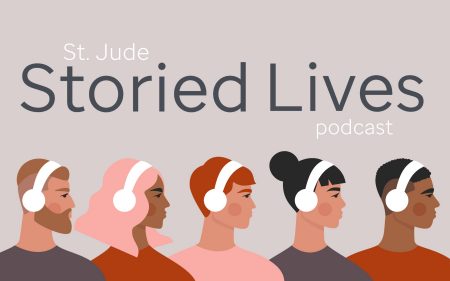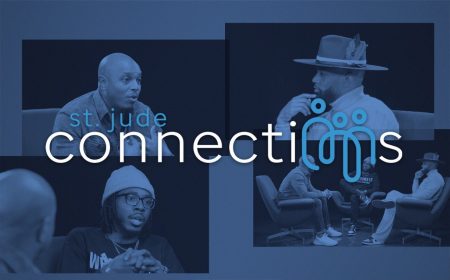Please turn your devide to portrait orientation

Click the A-to-Z grid to select letters


H is for Hope
An A-to-Z look at St. Jude and decades of inspired treatment
By David Williams | September 3, 2019
He was a desperate man, who did what desperate men often do.
He made a promise — a promise to the patron saint of hopeless causes, St. Jude Thaddeus.

“Show me my way in life,” said Danny Thomas, a struggling entertainer with a young family to support, “and someday I will build you a shrine.”
The rest is mystery. It has to be, right? How else to explain St. Jude Children’s Research Hospital, one man's promise that’s become an unprecedented beacon of hope and healing for the world.
Consider how it must have sounded, at the time: A hospital to cure childhood diseases thought to be incurable, built in the early 1960s segregated South and meant to treat all children, regardless of color or creed or a family’s socio-economic station.
Audacious is one word for it. Preposterous is another.
But it happened, thanks to self-described “proud beggar” Danny Thomas (1912-1991), a saloon entertainer who became an Emmy-winning TV star – but did his best work as a humanitarian who never forgot his promise.
And it’s happening still. The single, star-shaped building that opened on Feb. 4, 1962, has given way to a 66-acre campus where research and treatments have helped push the overall childhood cancer survival rate from 20 percent when the hospital opened to more than 80 percent today.
We’re taking an A to Z look at the history of St. Jude, and how Danny's promise is still being fulfilled today.
Join us on by clicking on the letters above to see what each means to us.
A
Amos Jacobs, “my true legal name,” as the man better known as Danny Thomas said in his autobiography, Make Room for Danny.
Also, A for American Lebanese Syrian Associated Charities (ALSAC), the organization Thomas founded in 1957 to fund the hospital of his dreams.
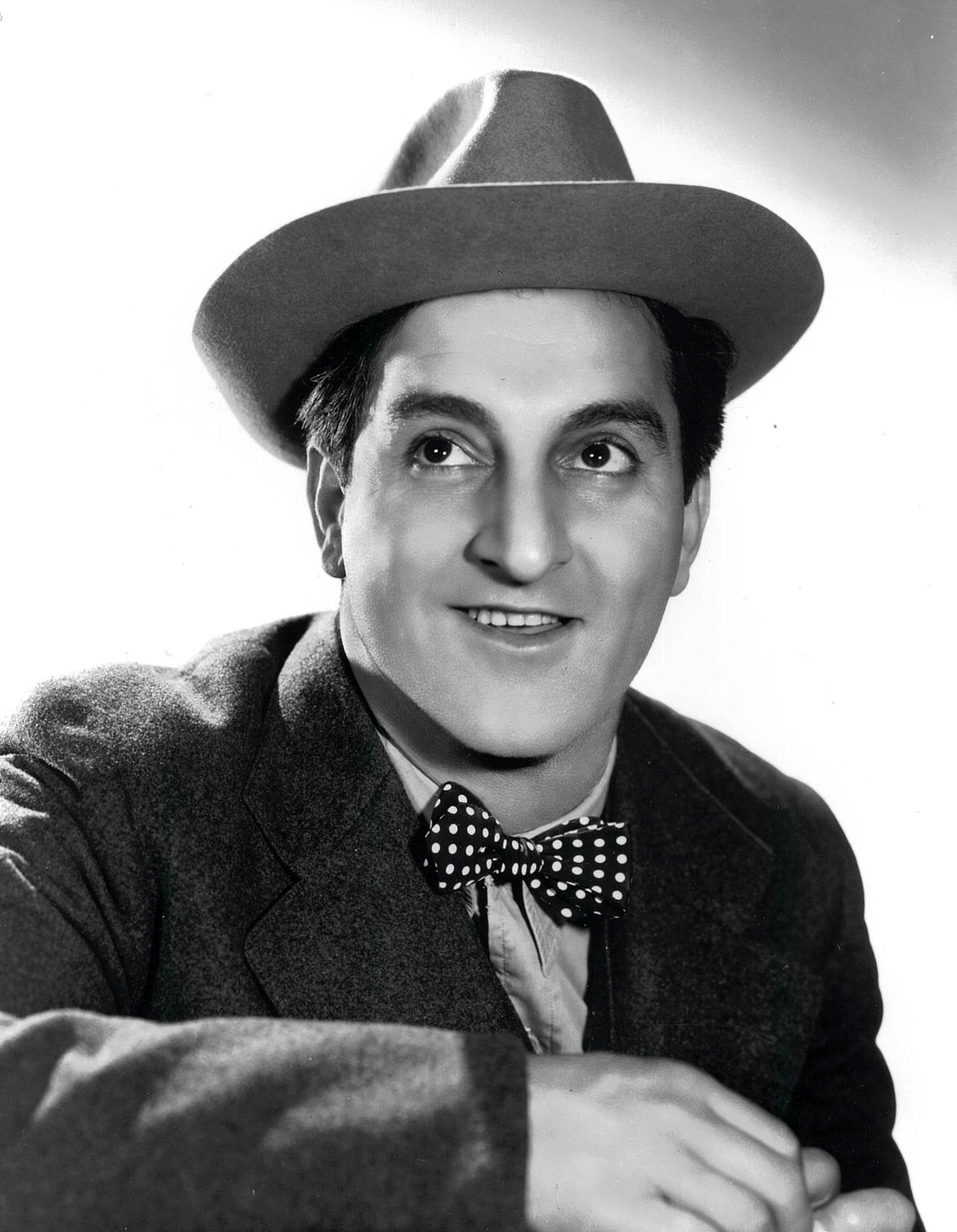
B
Billion. It will cost more than $1 billion to operate St. Jude this year and the majority of that must come from generous donors. But every little bit helps — the average individual donation is about $43.25.
C
No, not cancer, but the real Big C – children, St. Jude’s reason for being.
The hospital treats about 8,500 children with cancer and other life-threatening illnesses per year and freely shares its research to help children around the world.

D
Donors, like an 8-year-old girl named Caroline. She recently sent a single dollar bill and 40 cents in change to ALSAC’s Charlotte, North Carolina, office with a letter that brought tears to the eyes of the employees there — “little things,” she wrote, “go a long way.”
She was carrying on a tradition that began decades earlier, when Danny Thomas was still raising money to build St. Jude. Speaking to a crowd in Peoria, Illinois, he heard a young voice shout, “Hey, Danny! I want to help the poor, sick kids!” It was a blind boy named Billy Johnson, offering an envelope containing 75 cents. Danny was so touched that he saved the envelope and its contents, eventually finding a special place for them. (See: J.)
Caroline and Billy’s gifts called to mind the words, wisdom and giving spirit of our founder: “I’d rather have a million people give me a dollar than one give me a million,” Danny said. “That way you’ve got a million people involved.”
E
Elvis Presley. The King of Rock ‘n’ Roll was famous for giving away cars to complete strangers, but how about the time he gave a boat to St. Jude? This was on Feb. 14, 1964, in Long Beach, California, and it wasn’t just any boat, but the USS Potomac, the so-called “Floating White House” during its days as Franklin D. Roosevelt’s presidential yacht. (Another King — George VI of England — was a guest of FDR on the Potomac.)
The day of the boat presentation, Elvis was “dapper in a light continental suit, narrow patterned tie, and forelock of hair falling carelessly across his brow,” wrote Presley biographer Peter Guralnick. But Danny Thomas stole the show. In archival footage, he praises Elvis for his generosity, educates the press corps about St. Jude’s mission and the cost of running the hospital ($1.3 million the previous year, he says), cracks a few one-liners, and makes it clear St. Jude isn’t planning to start offering sightseeing cruises of the Mississippi River.
St. Jude sold the yacht for anywhere from $60,000 to $75,000 — reports vary. The ship went on to have numerous owners, spent time as a floating disco, was seized as a drug smugglers’ den by U.S. Customs officials in 1980, sank shortly thereafter, was refloated and restored, and these days is available for tours and cruises in San Francisco Bay.
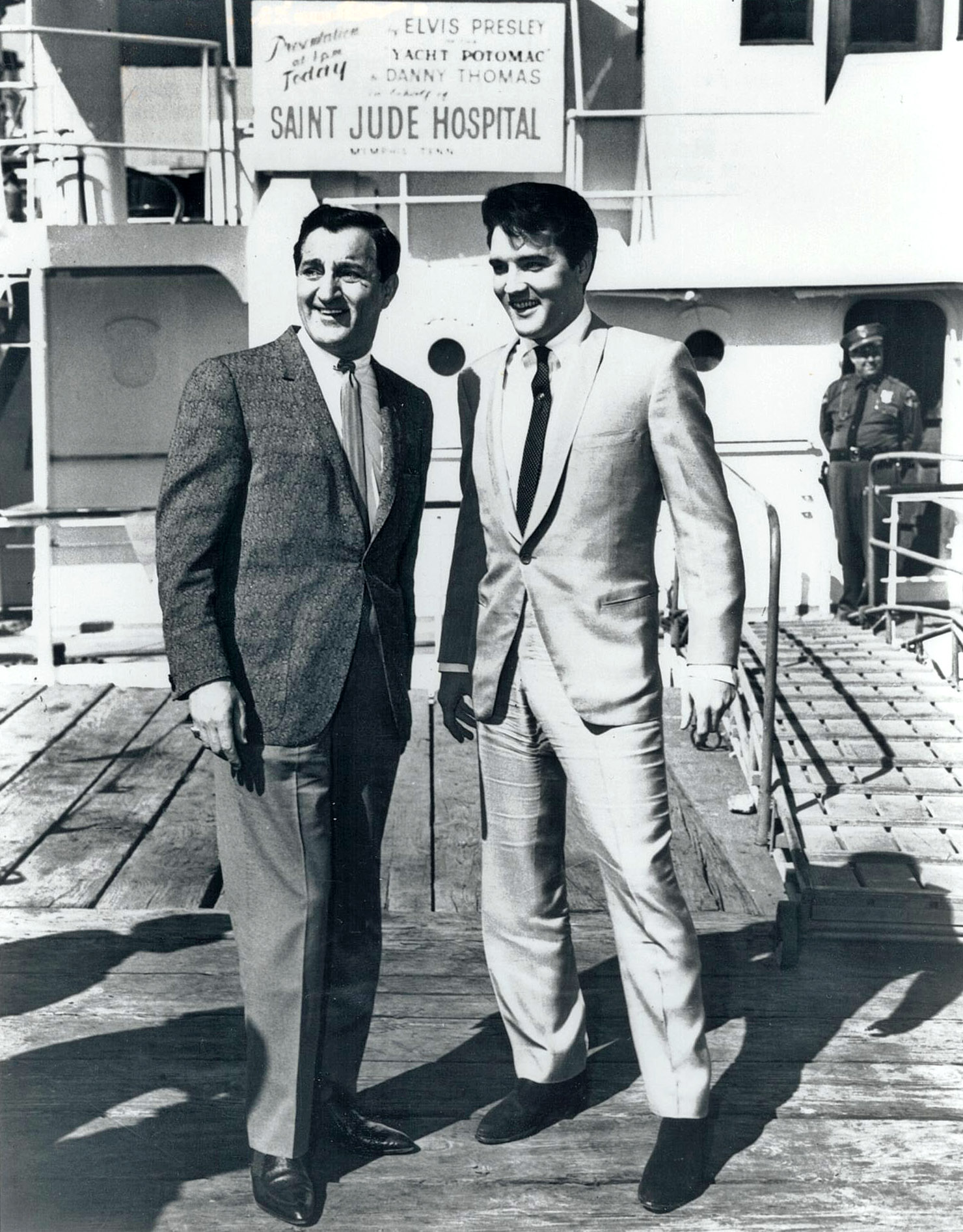
F
Friends. Danny Thomas knew the power of celebrities and friends in high places could help make the dream of St. Jude Children’s Research Hospital a reality. From Frank Sinatra, Bob Hope, Jack Benny, Lucille Ball, Sammy Davis, Jr., Milton Berle, George Burns, Diana Ross to 5 presidents (Eisenhower, Kennedy, Johnson, Ford and Reagan). His foresight was rewarded, just like his prayers were in his early, hardscrabble days when he prayed to a certain patron saint of hopeless causes.
That tradition was passed down to each generation, ensuring that money for treatment and research would be sustained. Marlo and Tony have enlisted their celebrity friends including Jennifer Aniston, Michael Strahan, Sofia Vergara, Jon Hamm, Luis Fonsi, Kelsea Ballerini, Darius Rucker, Jenna Dewan, Ray Romano, Ellen DeGeneres, Drew Barrymore, Armie Hammer, Emma Roberts, Yara Shahidi, Scott Eastwood and many others, who continue to help raise awareness and funds to support the important work and lifesaving discoveries made at St. Jude every day.
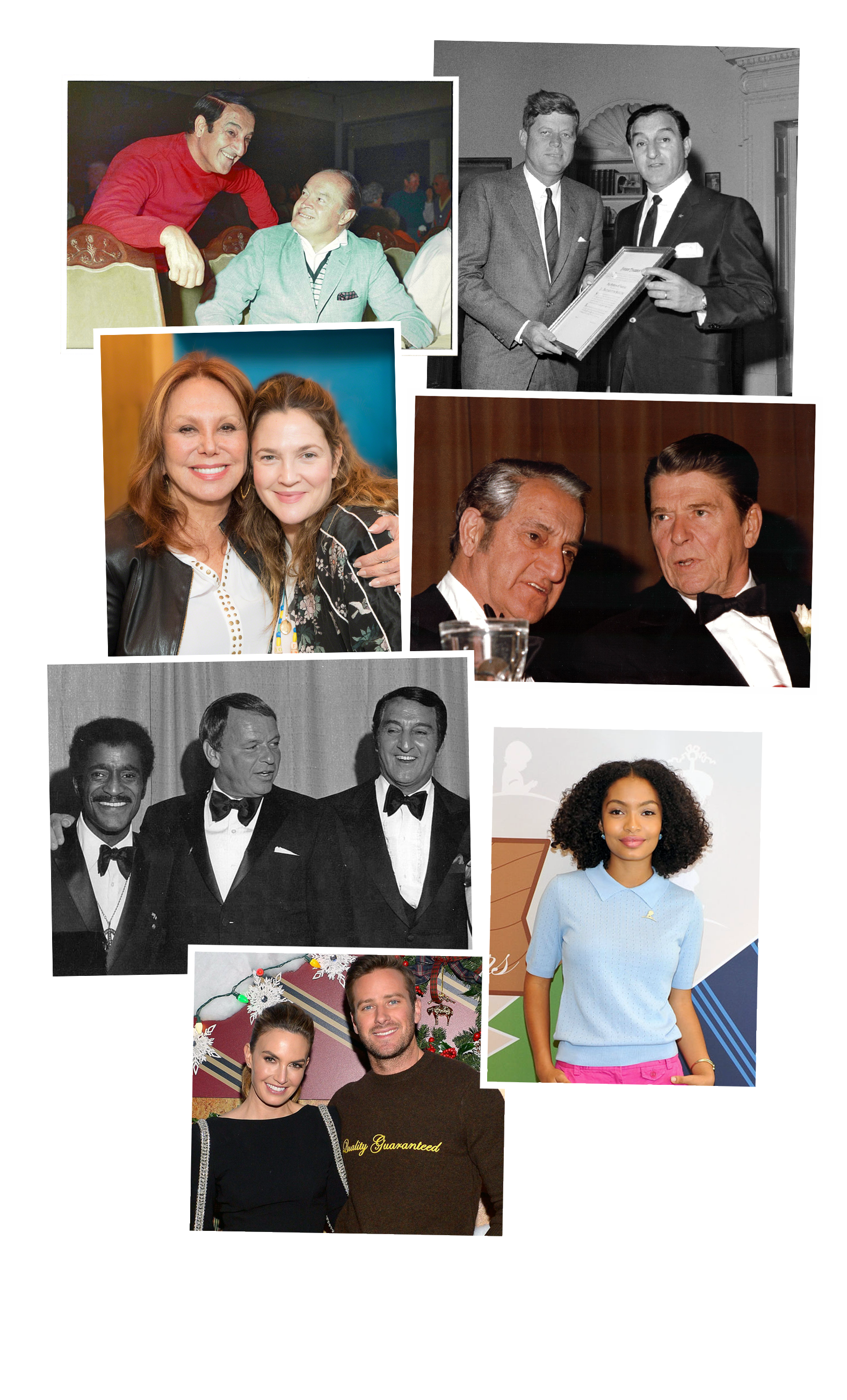
G
Global. 90 percent of pediatric cancer cases worldwide occur in low- and middle-income countries. And survival rates there are about what St. Jude faced in the U.S. when the hospital opened. Yes, it’s still 1962 for many sick children in the world’s poorest places.
To change that, a $100 million-plus initiative called St. Jude Global was announced in May 2018, and four months later St. Jude unveiled a collaboration with the World Health Organization aimed at curing at least 60 percent of children with six of the most common types of cancer by 2030.

H
Hope. The “Your First Hours” section of the hospital’s Family Guide covers everything from registration to consent forms to initial meetings with clinicians. It’s all very practical – and as tangible as a needle stick. But that same section also includes this passage:
The St. Jude staff believes that hope is essential to life, and that hope can directly influence the well-being of pediatric patients. … Having hope, for themselves or others, helps children and teens cope with hardships. The St. Jude staff has done extensive research on this subject.
David has been battling cancer at St. Jude almost three years. But he's finally celebrating his No More Chemo Party...and finally getting to go home.
I
Ira’s request. For many years, a man named Ira Jackson donated a portion of his Social Security check — his only source of income — to the hospital. Terminally ill, he wrote a letter to St. Jude, with a plea:
I am prepared for death, but the little children should have their chance to play and grow into healthy adults.
It is my last wish that you use this letter to find just one person who will say, “I’ll take Ira’s place.”
Nearly 900 people responded, becoming St. Jude Partners in Hope® and raising more than $150,000.
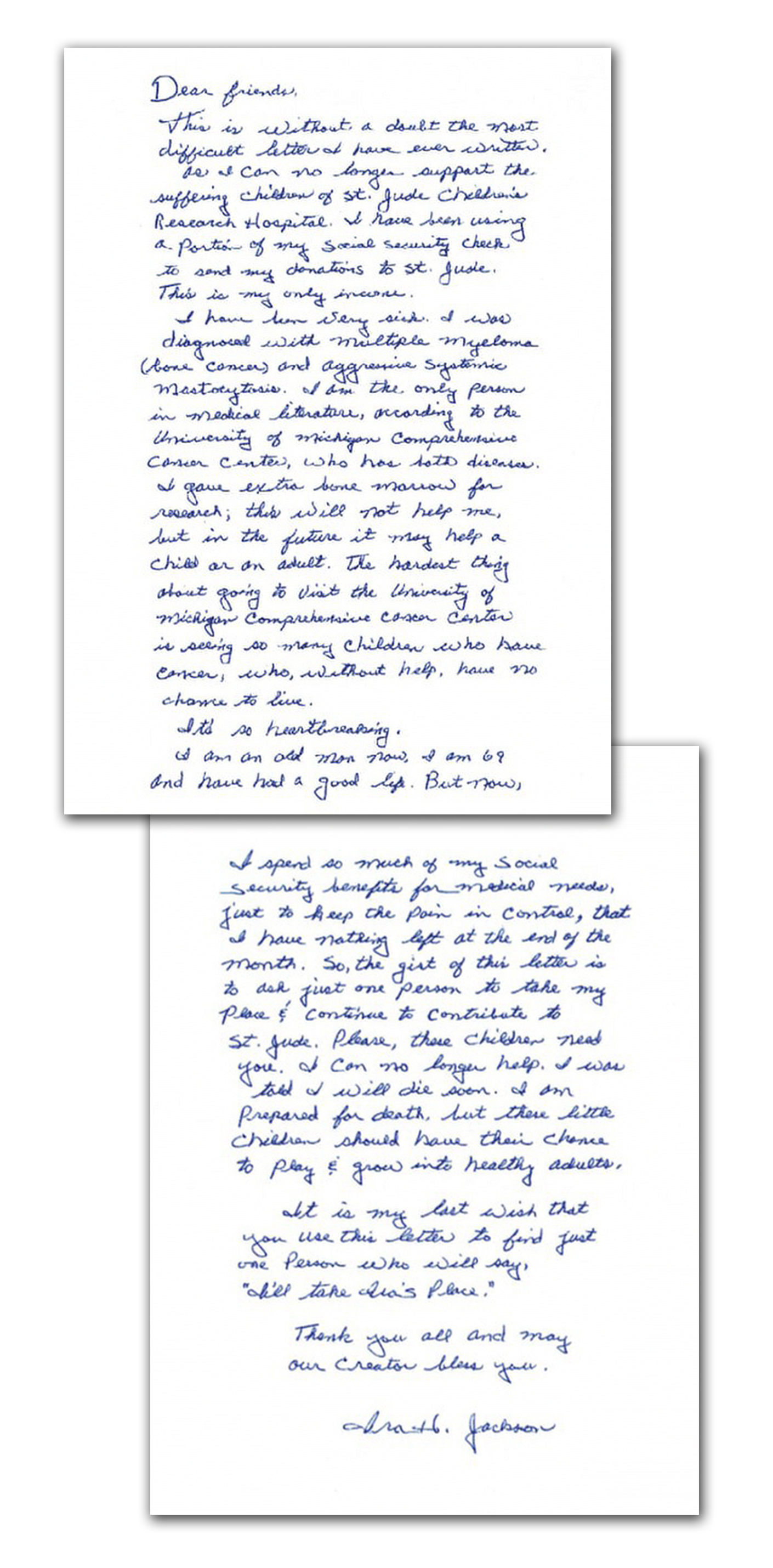
J
Jude Thaddeus — St. Jude, patron saint of hopeless causes.
A 10-foot-tall, white marble statue of St. Jude was unveiled at the hospital during dedication ceremonies in 1962. Inside the statue’s cornerstone are the coins given to Danny Thomas years earlier by the blind boy, Billy Johnson (see: D).
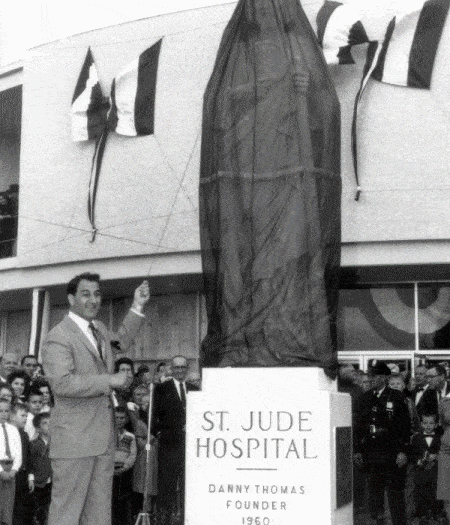
K
Kay Kafe – St. Jude’s communal gathering space for meals. There aren’t separate dining halls for medical staff, or for patients and families, or for the marketers and fundraisers of ALSAC. Everyone eats at the Kay. And the chefs are famous for their ingenuity and caring — making a Cheetos pizza for a patient who had to have a blood transfusion on her birthday; or calling another patient’s grandmother to get the recipe for her beloved mac-and-cheese.
Executive Chef Michael Vetro and Executive Chef Rick Farmer explain how the meals they create and prepare fit in to the life-saving mission at St. Jude Children's Research Hospital.
L
Lebanese – Danny Thomas’ heritage, and a great source of personal pride. ALSAC (see also: A) was formed in 1957 by 100 representatives of the Arab-American community. They were united by ancestry, an audacious dream and a desire to thank America for the freedoms it bestowed.
M
Marathon. St. Jude Memphis Marathon Weekend, the largest single-day fundraiser for the hospital, attracted a record 26,000 participants in 2018, raising $11.2 million.
The 26.2-mile course isn’t especially hilly, but runners know to brace for the emotional topography: More than a few at the starting line were brought to tears by patient Addie’s singing of the National Anthem — and then lifted up during the half-mile sweep through the St. Jude campus, cheered on by patients and their families, caregivers and supporters.

N
“No child should die in the dawn of life.” A simple declaration of an undeniable truth. Danny Thomas’ words remain our mission and our marching orders — they’re prominently displayed at the entrance of ALSAC’s headquarters on campus.

O
Owen, Randy. “Probably the most important thing I’ll ever do, except being a daddy and a husband, is St. Jude.” — said the man whose country music supergroup, Alabama, has sold 75 million records and had 33 No. 1 country hits.
Owen, recruited by Danny Thomas to rally the country music community around the hospital’s mission, founded Country Cares for St. Jude Kids®. It has become one of the most successful fundraising campaigns in radio history at $800 million and counting, and in 2019 celebrated its 30th anniversary.
Where country music has led, other radio platforms such as gospel, rock and Hispanic have followed in raising money for St. Jude through radiothons.
P
Pinkel, Dr. Donald. He became the first medical director at St. Jude — despite copious advice against joining an upstart Southern hospital created by “this Hollywood character,” as Pinkel said in a 2016 profile in Smithsonian magazine.
He had been chief of pediatrics at a renowned research hospital in his native Buffalo, N.Y., but a health-related need for warmer climes, and a genuine intrigue with the sort of hospital Thomas envisioned, brought him to Memphis. He arrived in his Volkswagen Bug, for a salary of $25,000.
Pinkel led St. Jude until 1973 and, along the way, “introduced the word ‘cure’ to cancer,” said Dr. James Downing, St. Jude’s current director and CEO.
“Should have gotten the Nobel Prize,” Danny Thomas said.

Q
Quotes — Danny Thomas had a million of them. How about this one from the opening of St. Jude on Feb. 4, 1962:
“It is true. It took a rabble-rousing, hook-nosed comedian to get your attention, but it took your heart, and your loving minds, and your generous souls, to make this fabulous dream come true.”
R
Racial inequality — a social cancer in need of a cure, when St. Jude opened in the segregated South of the early 1960s. And so, Thomas insisted St. Jude would treat children of all races, and that the hospital would be integrated on all levels of employment.
Cedric McCollins, the son of Mississippi sharecroppers, experienced St. Jude’s integrated hospital in the 1960s. At the clinic near his home, 2-year-old Cedric and his mother had to enter through the waiting-room door labeled “Colored.” The doctor there suspected a serious disease was the root of Cedric’s symptoms, and referred him to St. Jude, a place where the doors opened to all races.
“I got a second chance at life,” says Cedric, who beat cancer and went on to become a biologist and work for a federal health agency. “I try to live every day as if it’s my last.”

S
Samuel Stritch, Cardinal in the Roman Catholic Church. He mentored Thomas and steered him toward Memphis — where Stritch had served as a young priest — as a site for St. Jude.
Thomas tells the story in his autobiography. He was visiting the Cardinal in Chicago, telling him about building a hospital — a small clinic, really, with four beds — somewhere in the South. He was thinking of putting it “in the bayous of Louisiana, or maybe in Mississippi or Arkansas.”
Then “His Eminence” spoke:
He said, ‘Wait a minute. How are those kids going to get out there in the boondocks? And suppose they need a specialist? You’ve got to be near a medical center, where a lot of facilities are available to you. Take a look at the growing city of Memphis.’
It was another Memphis connection — Dr. Lemuel Diggs, on the faculty in the University of Tennessee medical school there — who gave Thomas’ idea a larger scope and a laser focus. Again, from Thomas’ autobiography:
Dr. Diggs said, ‘What we really need here is a research hospital for catastrophic children’s diseases — especially leukemia and, in black children, sickle-cell anemia.’ My little four-bed clinic idea went out the window, but who could complain.
Both conversations tell us something about Thomas. As a comedian, storyteller and actor he literally talked his way to fame. But the man could listen, as well.
And though it was his promise, his dream, Thomas never claimed to have done it alone. He tended toward self-deprecation — humor at his own expense. He made sport of his hooked nose, his humble background. And as for his “proud beggar” role in making St. Jude a reality, well, as he once said in a TV interview:
“Oh, I don’t really raise the funds. I’m just the braying jackass that makes a lot of noise.”
T
T is for the Thomas Next Generation– Tony, Terre and Marlo were raised in a home steeped with the spirit and tradition of gratitude and generosity. It was only natural that they have proudly elevated and expanded their father’s original dreams and vision when it came to St. Jude Children’s Research Hospital. Combining their own star power, producing acumen and fearlessness, the three siblings launched the annual holiday St. Jude Thanks and Giving campaign 15 years ago. This unprecedented campaign is a union of retail and corporate partners, celebrity friends, media, and thousands of supporters from across the United States. The Thanks and Giving campaign just passed the $1 billion milestone to continue to fulfill Danny’s mission that no family ever pays St. Jude for anything – not for treatment, travel, housing or food.
Terre served as a Board member for 18 years and is currently a Board member Emeritus. Tony currently serves as a member of the St. Jude/ALSAC Board of Directors and Governors and has been on the Board for nearly 20 years. Marlo is the National Outreach Director for St. Jude, and has received the Presidential Medal of Freedom in recognition of her humanitarian efforts. It is no wonder that the 3rd generation of Thomas’ (Danny’s grandchildren) have already begun developing innovative music, yoga and digital awareness programs to carry the mission into the future.

U
Unprecedented. The firsts of St. Jude are legion — from developing the first immunologic method to diagnose solid tumors in children (1965), to being the first hospital to identify important subtypes of acute lymphoblastic leukemia, proving that ALL is not a single disease and thus sparking new research directions and improved treatment (1975), to being first to adapt a computer-based, 3-D radiation therapy technique for pediatric brain tumor treatment (1995).
St. Jude opens the first proton therapy center dedicated solely to children and provides one of the most advanced radiation technologies yet for treatment of pediatric cancer.
V
Vergara, Sofia — to drop just one famous name among the many who support St. Jude. She and others like Jennifer Aniston, Michael Strahan, Luis Fonsi and Jon Hamm are continuing a tradition Danny Thomas started with the stars of his era (See: F).
W
Williams, Paul. The architect of the original star-shaped hospital building. He conceived, and donated, the design, but more than that he put a face — an African-American face — on Danny Thomas’ vision of a truly integrated St. Jude (see also: R).


X
Xylophone, and all of the other instruments patients can play in the St. Jude Music Therapy program. Music gives patients a creative outlet, a coping mechanism, a learning tool, and a way to express joy or let off steam. As music therapist Amy Love says, “Music can be such a healing thing in the hospital. There is no better setting to have music.”
The program is an example of the St. Jude philosophy of treating the whole child, not just the disease. Along with Music Therapy, there’s also Child Life, a program designed to reduce the stress and anxiety of patients, and the St. Jude School Program by Chili’s®, a highlight of which is kindergarten graduation.
Y
Y is for “Yucky,” as seen in the hospital’s ABCs of Cancer patient art display. A project of the St. Jude Child Life Program, the alphabetically-themed display lets patients use art to express themselves in ways that can be heartbreaking and hopeful, poignant and playful.
Needles are yucky and scary.
Throwing up is yucky.
Taking medicine is super yucky.
Cancer is mean and yucky.
Z
Zero. The number of bills received by patients from St. Jude for treatment, travel, housing and food. The average cost to treat a child with acute lymphoblastic leukemia (ALL), the most common form of childhood cancer, is about $300,000.


